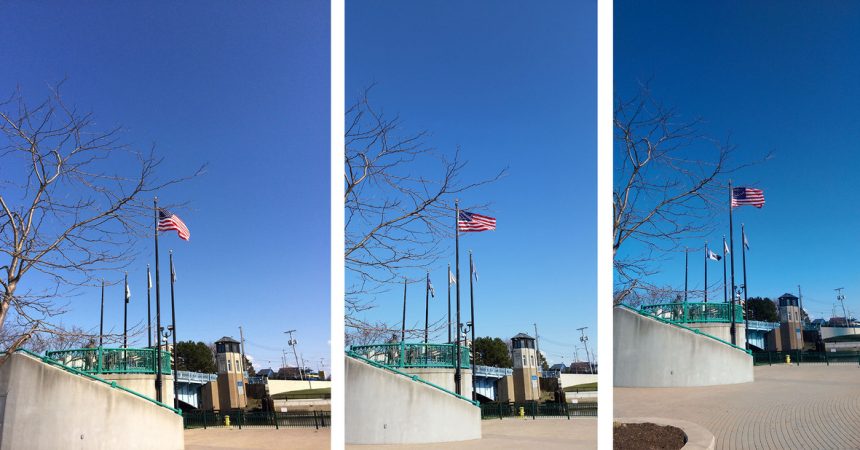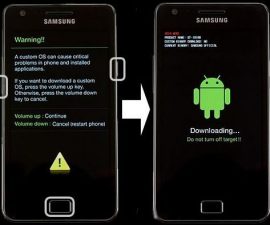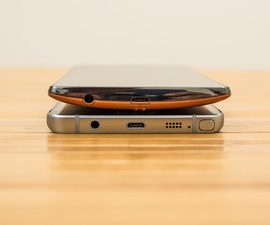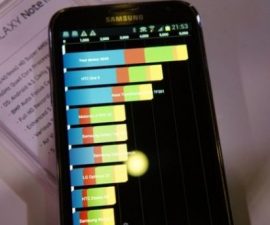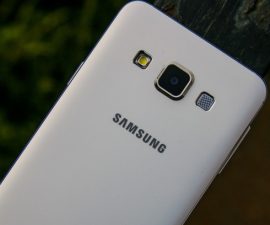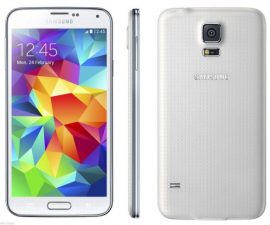iPhone 5s, Galaxy S5, and HTC One M8 Camera Quality
Smartphones have been the new “in” over the past few years, and they have been developing most of their features to perform the functions of other devices such as cameras. For some people, their choice of smartphone depends on the quality of the device’s camera. The cameras of the Samsung Galaxy S5, HTC One M8, and iPhone 5s have been pitted against each other to determine which one works best and to assist you in choosing which phone to buy (if you’re the kind who decides based on camera quality).
Camera specifications of the Galaxy S5, HTC One M8, and iPhone 5s
First up, let us take a look at what the cameras of these three devices have to offer.
Galaxy S5:
- The Samsung Galaxy S5 has a 16mp rear camera with 1.12 micrometers of pixel size
- Resolution of the camera is 5312×2988 and it has an aperture of f/2.2
- It has backside illumination which allows the sensor to get the most amount of light possible
HTC One M8:
- The HTC One M8 has a Duo camera (or two rear cameras) with 4mp and a pixel size of 2 micrometers. The second lens of the Duo camera merely collects information regarding the depth.
- Resolution of the camera is 1520z2688 and the aperture is f/2.0
- It also has backside illumination which allows the sensor to get the most amount of light possible
iPhone 5s:
- The iSight camera of the iPhone 5s has 8mp with 1.5 micrometers of pixel size.
- Resolution of the camera is 2448 x 3264 and the aperture is f/2.2
- It also has backside illumination which allows the sensor to get the most amount of light possible
Based on the camera specifications, the Galaxy S5 and the iPhone 5s are both capable of creating clear images with high resolution (and therefore, smoother pictures) for every day situations. In contrast, the HTC One M8 should perform well on low-light conditions. But we can’t really judge the camera of a device based on specifications alone, as these may not translate well in reality.
Testing the cameras of the Galaxy S5, HTC One M8, and iPhone 5s
- Picture stabilization has been enabled in the Galaxy S5
- The iPhone 5s is used in HDR Auto mode
- The HTC One M8 also used the HDR mode in certain photos (when necessary)
- The cameras of the three devices took only one shot each.
The parameters for comparison are the following:
- HDR photography
- Photos taken in low light
- Flash photography
- Digital zoom
- Panorama
- Depth of focus (bokeh)
- Action photography
- Macro shots
HDR photography
Note: the first photo (left) is taken with an iPhone 5s, the second photo (middle) with a Galaxy S5, and the third photo (right) with an HTC One M8


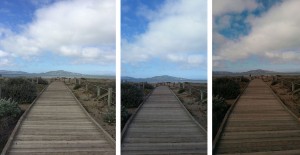
The observations:
- The iPhone 5s and the Galaxy S5 both produced photos that have bright, vivid colors. In comparison, the photos taken by the HTC One M8 always have a bluish tint and are not so great in bright/day lighting conditions.
- In terms of saturation, the iPhone 5s has natural hues whereas the Galaxy S5 have brighter hues.
The verdict:
- The iPhone 5s and the Galaxy S5 are tied in HDR photography, with their vivid photos.
Photos taken in low light
Note: the first photo (left) is taken with an iPhone 5s, the second photo (middle) with a Galaxy S5, and the third photo (right) with an HTC One M8


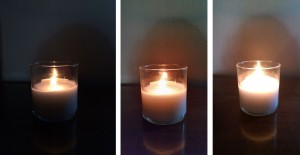
The observations:
- The Galaxy S5 and the HTC One M8 produced better-looking photos in a condition with naturally low light but are not so dark to necessitate the use of a flash.
- Some of the shots taken with the HTC One M8 has slightly more noise, but this is just in some scenarios.
The verdict:
- The HTC One M8 and the Galaxy S5 are tied for photos taken in low light as these two are more consistent in their shots
Flash photography
Note: the first photo (left) is taken with an iPhone 5s, the second photo (middle) with a Galaxy S5, and the third photo (right) with an HTC One M8



The observations:
- The flash of the iPhone 5s and Galaxy S5 provides still more realistic and balanced photos. There are some shots where the flash of the Galaxy S5 is sharper, but not by much. In comparison, the HTC One M8’s camera when used with a flash provides a yellow tint on the photo
The verdict:
- The iPhone 5s and the Galaxy S5 are tied in flash photography, with their not-too-sharp flash photos that are well-balanced, overall.
Digital zoom
Note: the first photo (left) is taken with an iPhone 5s, the second photo (middle) with a Galaxy S5, and the third photo (right) with an HTC One M8. The photos were taken in the maximum zoom allowable by the devices.



The observations:
- The iPhone 5s allows you to zoom the most without killing the image quality. The Galaxy S5 is able to zoom on the image while keeping it smooth, but it is still less than what the iPhone can do. The HTC One M8 is the weakest in this category as the images taken ended up being noisy and too unpolished.
The verdict:
- The iPhone 5s is the sole winner here as it is able to zoom farthest while still providing decent photos.
Panorama
Note: the first photo (left) is taken with an iPhone 5s, the second photo (middle) with a Galaxy S5, and the third photo (right) with an HTC One M8..
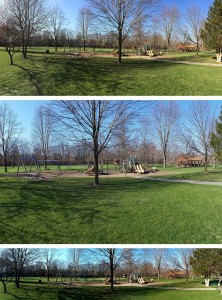
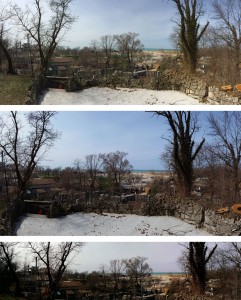

The observations:
- The camera software of the iPhone 5s is a clear advantage here, as it gives very well-balanced images. The same is true with the Galaxy S5, which is further boosted by its surround shot feature (something that can be downloaded for free in the app store). HTC is again the odd one out as it has issues with brightness.
The verdict:
- Once again, the iPhone 5s and the Galaxy S5 are tied in panoramic mode because of the balanced images that the cameras of these devices can produce.
Depth of focus (bokeh)
Note: the first photo (left) is taken with an iPhone 5s, the second photo (middle) with a Galaxy S5, and the third photo (right) with an HTC One M8..


The observations:
- The HTC One M8 and the Galaxy S5 both have dedicated features for the bokeh or the depth of focus whereas the iPhone 5s has none.
- For the Galaxy S5, it’s called the Selective Focus which does an okay work, but you may have to do several shots before you get your desired result.
- For the HTC One M8, it’s called the UFocus, which has a “post-capture” outcome that can conveniently be done to any photo.
- The iPhone 5s automatically adds blurriness in its photos, although this is not really apparent often.
The verdict:
- The HTC One M8 wins in this category as its UFocus feature is very functional and performs better than the Selective Focus feature of the Galaxy S5.
Action photography
Note: the first photo (left) is taken with an iPhone 5s, the second photo (middle) with a Galaxy S5, and the third photo (right) with an HTC One M8..

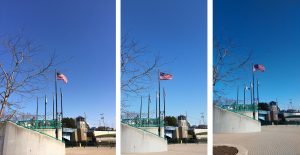
The observations:
- Action photography are all okay in all three devices, and there was barely any motion blur. However, the iPhone 5s and the Galaxy S5 are consistently producing solid images as compared to the HTC One M8 which tends to have overcast images.
The verdict:
- The iPhone 5s and Galaxy S5 wins in action photography because of its consistency and good-quality images.
Macro shots
Note: the first photo (left) is taken with an iPhone 5s, the second photo (middle) with a Galaxy S5, and the third photo (right) with an HTC One M8..


The observations:
- The iPhone 5s and Galaxy S5 once again shows their capacity in producing compact photos. Macro shots from the two devices are well-balanced and as good as can be. The only slight and very minimal downside with the iPhone 5s is that it loses focus when you come super close to the subject.
- The HTC One M8 performs poorly in bright light conditions, and this shows when you take macro shots.
The verdict:
- The iPhone 5s and the Galaxy S5 are again tied in taking macro shots. The main disadvantage here of the HTC One M8 is its weakness in taking shots in bright lighting conditions.
The overall verdict:
All in all, the HTC One M8 has the weakest camera as compared to the iPhone 5s and the Samsung Galaxy S5. Here is a summary of what the three devices are best at:
Galaxy S5:
- HDR photography
- Low light photography
- Flash photography
- Panorama
- Action photography
- Macro shots
HTC One M8:
- Low light photography
- Depth of focus (bokeh)
iPhone 5s:
- HDR photography
- Flash photography
- Digital zoom
- Panorama
- Action photography
- Macro shots
Obviously, if the camera’s quality is a deciding factor for you, then go with either the Galaxy S5 or the iPhone 5s.
Are you one of those people? Share with us your thoughts by participating in the comments section below!
SC
[embedyt] https://www.youtube.com/watch?v=z6rkeRcg7Qs[/embedyt]
